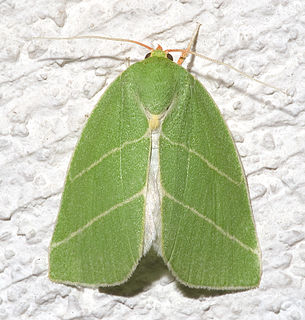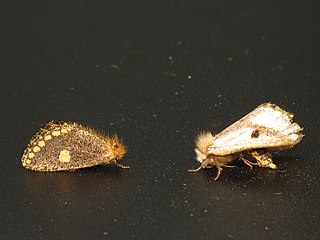
Phyllorhiza punctata is a species of jellyfish, also known as the floating bell, Australian spotted jellyfish, brown jellyfish or the white-spotted jellyfish. It is native to the western Pacific from Australia to Japan, but has been introduced widely elsewhere. It feeds primarily on zooplankton. P. punctata generally can reach up to 50 centimetres (20 in) in bell diameter, but in October 2007, one 72 cm (28 in) wide, perhaps the largest ever recorded, was found on Sunset Beach, North Carolina.

Nudaria is a genus of moths in the subfamily Arctiinae erected by Adrian Hardy Haworth in 1809.

Sarrothripini is a tribe of subfamily Chloephorinae of the moth family Nolidae.

Lichenaula is a genus of Australian moth of the family Xyloryctidae.
Aeolochroma turneri is a moth of the family Geometridae first described by Thomas Pennington Lucas in 1890. It is found in Australia's Northern Territory and Queensland.

Dysauxes punctata is a moth of the family Erebidae. It was described by Johan Christian Fabricius in 1781. It is found in France, Portugal, Spain, Switzerland, Austria, Italy, Croatia, Bosnia and Herzegovina, North Macedonia, Greece, Turkey, Romania, Ukraine, Russia and North Africa.
Eressa angustipenna, the black-headed wasp moth, is a moth of the family Erebidae. It was described by Thomas Pennington Lucas in 1890. It is found in Australia, as well as the Philippines.
Poliosia fragilis is a moth in the family Erebidae. It was described by Thomas Pennington Lucas in 1890. It is found in Queensland, Australia.
Scaptesyle equidistans is a moth in the subfamily Arctiinae. It was described by Thomas Pennington Lucas in 1890. It is found in Australia, where it has been recorded from Queensland and New South Wales.
Giaura tetragramma is a moth in the family Nolidae. It was described by George Hampson in 1905. It is found on Fiji and on Samoa (Upolu). The wingspan is about 20 mm. The forewings are pale ashen grey, with a darker brown base and with a narrow darker external line. This is followed by a broad pale area, which is widest in the inner marginal area. Here, a very broad, slightly darker postmedian area reaches all across the wing. This area is bounded externally by a white line. There is a dark subterminal line. The hindwings are pale grey, with much very fine brownish irroration (sprinkling).
Catoryctis mediolinea is a moth in the family Xyloryctidae. It was described by Thomas Pennington Lucas in 1894. It is found in Australia, where it has been recorded from New South Wales and Queensland.
Catoryctis nonolinea is a moth in the family Xyloryctidae. It was described by Thomas Pennington Lucas in 1894. It is found in Australia, where it has been recorded from New South Wales and Queensland.
Catoryctis truncata is a moth in the family Xyloryctidae. It was described by Thomas Pennington Lucas in 1902. It is found in Australia, where it has been recorded from New South Wales and Queensland.
Cryptophasa tecta is a moth in the family Xyloryctidae. It was described by Thomas Pennington Lucas in 1894. It is found in Australia, where it has been recorded from the Northern Territory and Queensland.
Cryptophasa cannea is a moth in the family Xyloryctidae. It was described by Thomas Pennington Lucas in 1901. It is found in Australia, where it has been recorded from Queensland.
Illidgea epigramma is a moth in the family Xyloryctidae. It was described by Edward Meyrick in 1890. It is found in Australia, where it has been recorded from the Australian Capital Territory, New South Wales, Queensland and South Australia.
Pilostibes serpta is a moth in the family Xyloryctidae. It was described by Thomas Pennington Lucas in 1901. It is found in Australia, where it has been recorded from New South Wales, Queensland, South Australia and Western Australia.
The field elm cultivar 'Punctata' ['spotted', the leaf] first appeared in the 1886–87 catalogue of Simon-Louis of Metz, France, as U. campestris punctata. It was distributed by the Späth nursery, Berlin, in the 1890s and early 1900s as U. campestris punctataSim.-Louis, the Späth catalogue listing it separately from U. campestris fol. argenteo-variegata and from U. campestris fol. argenteo-marginata. Green considered it possibly a synonym of the Field Elm cultivar 'Argenteo-Variegata'.
Giaura tortricoides is a moth of the family Nolidae first described by Francis Walker in 1865. It is found in Sri Lanka, Japan, Andaman Islands, Borneo, Sumatra, Flores, Sulawesi, New Guinea, Bismarck Islands and Australia.

Epicoma protrahens is a processional moth of the family Notodontidae first described by Thomas Pennington Lucas in 1890. It is found on the east coast of Australia.






